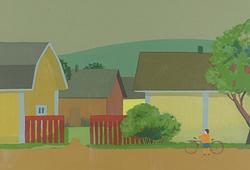Ola Billgren
"Klassiskt tema"
Signerad Ola Billgren och daterad -82 a tergo. Duk 150 x 150 cm.
Exhibitions
Rooseum, Malmö, och Moderna Museet, Stockholm, "Album Ola Billgren, En retrospektiv", 14/5-4/8 1991 samt 26/10-8/12 1991.
Literature
Douglas Feuk och Anne Ring Petersen,"Ola Billgren, Måleri Paintings", Bra Böcker och Galerie Leger, 2000, avbildad på helsida i färg sid 165.
Utställningskatalog "Album Ola Billgren, En retrospektiv", 1991, vol I, avbildad på helsida i färg sid 93.
Designer
Ola Billgren was born in 1940 in Copenhagen but based his career in Sweden. Billgren was self-taught, having only been trained by his parents Hans and Grete Billgren. Ola worked within the mediums of graphic art, watercolour, collage, photography, film, and scenography. He was also an author and culture critic. Known for his versatility, Billgren cultivated a relationship between art and reality in his work.
During the 1960s, he transitioned from abstract expressionism to photographic realism. Over time, his paintings evolved into a fusion of abstract and photorealistic styles, resulting in romantic landscapes where he examined the interplay of light and color. Forms dissolved, and colors were reduced to monochrome, single-colored surfaces that were richly worked and varied.
In the late 1980s, he returned to urban environments in large cityscapes, often painted from a high perspective but maintaining the impressionistic approach seen in his landscapes. Ola Billgren's influence on recent decades of art has been significant. His work is represented in institutions such as Musée National d'art Moderne Centre George Pompidou in Paris and Moderna Museet in Stockholm.




























